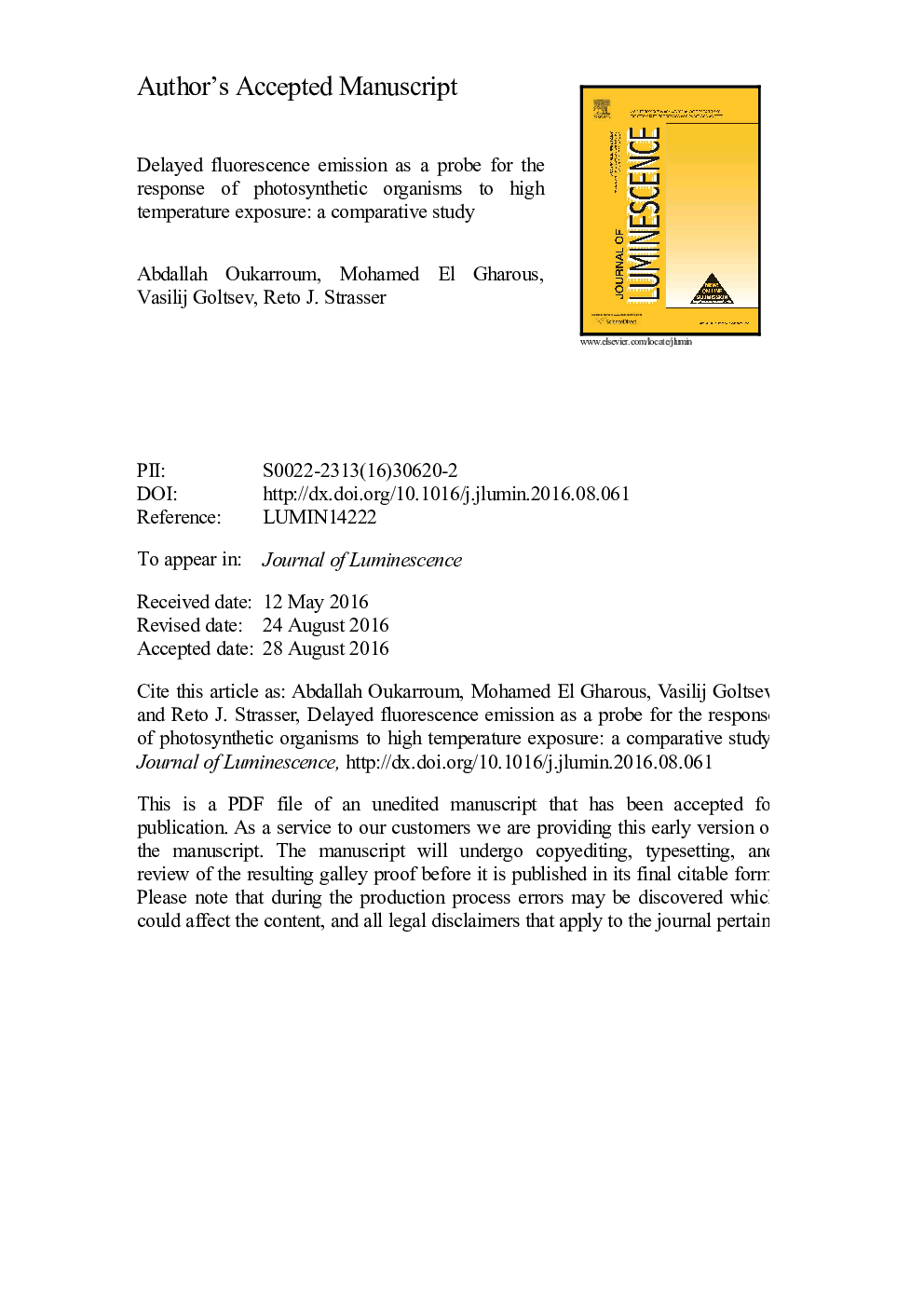| کد مقاله | کد نشریه | سال انتشار | مقاله انگلیسی | نسخه تمام متن |
|---|---|---|---|---|
| 5398170 | 1505881 | 2016 | 36 صفحه PDF | دانلود رایگان |
عنوان انگلیسی مقاله ISI
Delayed fluorescence emission as a probe for the response of photosynthetic organisms to high temperature exposure: A comparative study
ترجمه فارسی عنوان
انتشار فلورسانس تاخیری به عنوان یک پروب برای پاسخگویی به موجودات فتوسنتز در معرض قرار گرفتن در معرض دمای بالا: یک مطالعه تطبیقی
دانلود مقاله + سفارش ترجمه
دانلود مقاله ISI انگلیسی
رایگان برای ایرانیان
کلمات کلیدی
حرارت درمانی، اکسیژن تکامل یافته پیچیده، فلوئورسانس فوری فلورسانس تاخیری انعکاس نور 820 نانومتر،
موضوعات مرتبط
مهندسی و علوم پایه
شیمی
شیمی تئوریک و عملی
چکیده انگلیسی
The effects of a short-term exposure (40 s) to 50 °C on the prompt fluorescence (PF), delayed fluorescence (DF) and 820 nm reflection (MR) signals in three different photosynthetic organisms: Pisum sativum (angiosperm plant), Ginkgo biloba (gymnosperm tree) and thalli of Parmelina tiliacea (Hoffm.) Ach (lichen) were investigated. The aim of this study was to understand the relationship between prompt PF, DF and MR when the oxygen evolving complex (OEC) is destroyed. The signals of PF, DF and MR were measured simultaneously in plants in vivo to probe heat-induced damages in the photosynthetic electron transfer. PF is characterised by a polyphasic fluorescence rise OJIPSMT and DF induction curve has several maxima (In) and numbered in sequence according to their appearance during illumination. In control condition (25 °C) leaves of pea plants yield a typical OJIP rise with a flat P-step (0.2-2 s) and in G. biloba and P. tiliacea thalli, the P-level was split into two peaks, the first peak P (0.2 s) is followed by a decrease of the fluorescence intensity to a dip (S) and a subsequent rise to a second peak (M). An antiparallel relation between J-I-P-S and DF curves was also observed. Methyl viologen (MV) reduced the amplitude of the I-P phase of the PF curve and this change was accompanied by a disappearance of the PSM transient. In the presence of MV, the DF intensity remained higher; and the I4 peak disappeared. We suggested that P-S-M rise from PF and I4 peak might be related to an acceleration of intersystem electron transport. After 50 °C incubation, significant changes appeared in the PF, DF and MR transients and that were dependent on the photosynthetic sample. Heat treatment provoked a down regulation of electrons donation by the OEC in the three plant species and the re-reduction of P700+ and PC+ started earlier and began already after 10 ms of illumination. Inhibition of the donation of electrons by OEC after 50 °C incubation indicates that DF induction depends on the concentrations of QAâ and P680+ and the proton gradient.
ناشر
Database: Elsevier - ScienceDirect (ساینس دایرکت)
Journal: Journal of Luminescence - Volume 180, December 2016, Pages 321-327
Journal: Journal of Luminescence - Volume 180, December 2016, Pages 321-327
نویسندگان
Abdallah Oukarroum, Mohamed El Gharous, Vasilij Goltsev, Reto J. Strasser,
